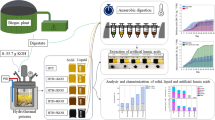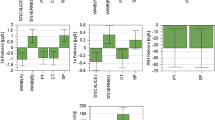Abstract
Co-pyrolysis with biomass is a promising solution to obtain high-quality products for sewage sludge (SS) treatment. In the present study, a thermogravimetric analyzer (TGA) and fixed bed reactor were used to investigate the synergistic effect and bio-oil characteristics during co-pyrolysis of SS and pinewood sawdust (WS). The results show a significant interaction between SS and WS, and the most apparent synergistic effect appears at the WS proportion of 50 wt. %. Co-pyrolysis of SS with WS promotes the generation of bio-oil while reducing gas formation, but less effect can be observed on the char yield. In the case of 50 wt. % WS addition, the maximum bio-oil yield (40.54%) was obtained at 550 °C, which was increased by 13.65% relative to the calculated value. Moreover, at 550 °C, the production of acids, sugars, and nitrogen-containing compounds during co-pyrolysis decreased by 47.68%, 54.34%, and 71.89%, respectively. In the meanwhile, the phenolic compounds are 29.92% higher than the theoretical value. Besides, high temperatures can decrease acids, alcohols, ketones, esters, and sugars and increase hydrocarbon production during co-pyrolysis. The above results indicated that the addition of WS can effectively improve the quality of bio-oil from SS pyrolysis.








Similar content being viewed by others
References
Lin KH, Lai NN, Zeng JY et al (2017) Temperature influence on product distribution and characteristics of derived residue and oil in wet sludge pyrolysis using microwave heating. Sci Total Environ 584–585:1248–1255. https://doi.org/10.1016/j.scitotenv.2017.01.195
Qin JY, Wang CZ, Li XG et al (2019) Turning sewage sludge into sintering fuel based on the pyrolysis I: lipid content and residual metal. Environ Sci Pollut Res Int. https://doi.org/10.1007/s11356-019-05836-1
Trabelsi ABH, Zaafouri K, Friaa A et al (2020) Municipal sewage sludge energetic conversion as a tool for environmental sustainability: production of innovative biofuels and biochar. Environ Sci Pollut Res Int. https://doi.org/10.1007/s11356-020-11400-z
Haghighat M, Majidian N, Hallajisani A et al (2020) Production of bio-oil from sewage sludge: a review on the thermal and catalytic conversion by pyrolysis. Sustainable Energy Technol Assess 42:100870. https://doi.org/10.1016/j.seta.2020.100870
Hu YJ, Yu WJ, Wibowo H et al (2019) Effect of catalysts on distribution of polycyclic-aromatic hydrocarbon (PAHs) in bio-oils from the pyrolysis of dewatered sewage sludge at high and low temperatures. Sci Total Environ 667:263–270. https://doi.org/10.1016/j.scitotenv.2019.02.320
Badrolnizam R, Elham O, Hadzifah S et al (2019) Sewage sludge conversion via hydrothermal liquefaction (HTL)—a preliminary study. J Phys.: Conf Ser 1349:12108. https://doi.org/10.1088/1742-6596/1349/1/012108
Chen YJ, Zhang L, Zhang YT et al (2019) Pressurized pyrolysis of sewage sludge: process performance and products characterization. J Anal Appl Pyrol 139:205–212. https://doi.org/10.1016/j.jaap.2019.02.007
Liu Y, Ran C, Siyal AA et al (2020) Comparative study for fluidized bed pyrolysis of textile dyeing sludge and municipal sewage sludge. J Hazard Mater 396:122619. https://doi.org/10.1016/j.jhazmat.2020.122619
Tang SQ, Zheng CM, Zhang ZT (2018) Effect of inherent minerals on sewage sludge pyrolysis: product characteristics, kinetics and thermodynamics. Waste Manage 80:175–185. https://doi.org/10.1016/j.wasman.2018.09.012
Praspaliauskas M, Pedišius N, Striu̅gas N, (2018) Elemental migration and transformation from sewage sludge to residual products during the pyrolysis process. Energy Fuels 32:5199–5208. https://doi.org/10.1021/acs.energyfuels.8b00196
Karaca C, Sözen S, Orhon D et al (2018) High temperature pyrolysis of sewage sludge as a sustainable process for energy recovery. Waste Manage 78:217–226. https://doi.org/10.1016/j.wasman.2018.05.034
Capodaglio AG, Callegari A (2018) Feedstock and process influence on biodiesel produced from waste sewage sludge. J Environ Manage 216:176–182. https://doi.org/10.1016/j.jenvman.2017.03.089
Capodaglio A, Olsson G (2020) Energy issues in sustainable urban wastewater management: use, demand reduction and recovery in the urban water cycle. Sustainability 12:266. https://doi.org/10.3390/su12010266
Xiao KK, Yu ZC, Wang H et al (2019) Investigation on emission control of NOx precursors and phosphorus reclamation during pyrolysis of ferric sludge. Sci Total Environ 670:932–940. https://doi.org/10.1016/j.scitotenv.2019.03.223
Liu H, Yi LL, Hu HY et al (2017) Emission control of NOx precursors during sewage sludge pyrolysis using an integrated pretreatment of Fenton peroxidation and CaO conditioning. Fuel 195:208–216. https://doi.org/10.1016/j.fuel.2017.01.067
Zhou Y, Liu YZ, Jiang WB et al (2019) Effects of pyrolysis temperature and addition proportions of corncob on the distribution of products and potential energy recovery during the preparation of sludge activated carbon. Chemosphere 221:175–183. https://doi.org/10.1016/j.chemosphere.2019.01.026
Zhu JJ, Yang Y, Yang L et al (2018) High quality syngas produced from the co-pyrolysis of wet sewage sludge with sawdust. Int J Hydrogen Energy 43:5463–5472. https://doi.org/10.1016/j.ijhydene.2018.01.171
Deng SH, Tan HZ, Wang XB et al (2017) Investigation on the fast co-pyrolysis of sewage sludge with biomass and the combustion reactivity of residual char. Biores Technol 239:302–310. https://doi.org/10.1016/j.biortech.2017.04.067
Guo J, Ren X, Li S et al (2021) The impact of blending with poplar wood on the co-pyrolysis characteristics of waste particleboards. Biomass Conv Bioref 32:1–8. https://doi.org/10.1007/s13399-021-01520-y
Bolognesi S, Bernardi G, Callegari A et al (2019) Biochar production from sewage sludge and microalgae mixtures: properties, sustainability and possible role in circular economy. Biomass Conv Bioref 11:289–299. https://doi.org/10.1007/s13399-019-00572-5
Duman G, Yanik J (2017) Two-step steam pyrolysis of biomass for hydrogen production. Int J Hydrogen Energy 42:17000–17008. https://doi.org/10.1016/j.ijhydene.2017.05.227
Echresh Zadeh Z, Abdulkhani A, Saha B (2021) A comparative production and characterisation of fast pyrolysis bio-oil from Populus and Spruce woods. Energy 214:118930. https://doi.org/10.1016/j.energy.2020.118930
Wang CX, Bi HB, Lin QZ et al (2020) Co-pyrolysis of sewage sludge and rice husk by TG-FTIR-MS: pyrolysis behavior, kinetics, and condensable/non-condensable gases characteristics. Renewable Energy 160:1048–1066. https://doi.org/10.1016/j.renene.2020.07.046
Zhang WJ, Yuan CY, Xu J et al (2015) Beneficial synergetic effect on gas production during co-pyrolysis of sewage sludge and biomass in a vacuum reactor. Biores Technol 183:255–258. https://doi.org/10.1016/j.biortech.2015.01.113
Wang ZP, Xie LK, Liu K et al (2019) Co-pyrolysis of sewage sludge and cotton stalks. Waste Manage 89:430–438. https://doi.org/10.1016/j.wasman.2019.04.033
Samanya J, Hornung A, Apfelbacher A et al (2012) Characteristics of the upper phase of bio-oil obtained from co-pyrolysis of sewage sludge with wood, rapeseed and straw. J Anal Appl Pyrol 94:120–125. https://doi.org/10.1016/j.jaap.2011.11.017
Zuo W, Jin BS, Huang YJ et al (2014) Characterization of top phase oil obtained from co-pyrolysis of sewage sludge and poplar sawdust. Environ Sci Pollut Res 21:9717–9726. https://doi.org/10.1007/s11356-014-2887-7
Alvarez J, Amutio M, Lopez G et al (2015) Fast co-pyrolysis of sewage sludge and lignocellulosic biomass in a conical spouted bed reactor. Fuel 159:810–818. https://doi.org/10.1016/j.fuel.2015.07.039
Zhou C, Zhang Y, Liu Y et al (2021) Co-pyrolysis of textile dyeing sludge and red wood waste in a continuously operated auger reactor under microwave irradiation. Energy 218:119398. https://doi.org/10.1016/j.energy.2020.119398
Sun LZ, Zhang XD, Chen L et al (2015) Effect of preparation method on structure characteristics and fast pyrolysis of biomass with Fe/CaO catalysts. J Anal Appl Pyrol 116:183–189. https://doi.org/10.1016/j.jaap.2015.09.011
Chen L, Zhang XD, Sun LZ et al (2016) Study on the fast pyrolysis of oil sludge and its product distribution by PY-GC/MS. Energy Fuels 30:10222–10227. https://doi.org/10.1021/acs.energyfuels.6b01991
Yu ZS, Dai MQ, Huang MM et al (2018) Catalytic characteristics of the fast pyrolysis of microalgae over oil shale: analytical Py-GC/MS study. Renewable Energy 125:465–471. https://doi.org/10.1016/j.renene.2018.02.136
Ma WC, Rajput G, Pan MH et al (2019) Pyrolysis of typical MSW components by Py-GC/MS and TG-FTIR. Fuel 251:693–708. https://doi.org/10.1016/j.fuel.2019.04.069
Cao J-P, Xiao X-B, Zhang S-Y et al (2011) Preparation and characterization of bio-oils from internally circulating fluidized-bed pyrolyses of municipal, livestock, and wood waste. Biores Technol 102:2009–2015. https://doi.org/10.1016/j.biortech.2010.09.057
Francioso O, Rodriguez-Estrada MT, Montecchio D et al (2010) Chemical characterization of municipal wastewater sludges produced by two-phase anaerobic digestion for biogas production. J Hazard Mater 175:740–746. https://doi.org/10.1016/j.jhazmat.2009.10.071
Nanda S, Dalai A, Berruti F et al (2016) Biochar as an exceptional bioresource for energy, agronomy, carbon sequestration, activated carbon and specialty materials. Waste Biomass Valoriz 7:201–235. https://doi.org/10.1007/s12649-015-9459-z
Masnadi MS, Habibi R, Kopyscinski J et al (2014) Fuel characterization and co-pyrolysis kinetics of biomass and fossil fuels. Fuel 117:1204–1214. https://doi.org/10.1016/j.fuel.2013.02.006
Huang F, Yu Y, Huang H (2018) Temperature influence and distribution of bio-oil from pyrolysis of granular sewage sludge. J Anal Appl Pyrol 130:36–42. https://doi.org/10.1016/j.jaap.2018.01.030
Gerasimov G, Khaskhachikh V, Potapov O et al (2019) Pyrolysis of sewage sludge by solid heat carrier. Waste Manage 87:218–227. https://doi.org/10.1016/j.wasman.2019.02.016
Arazo RO, Genuino DAD, de Luna MDG et al (2017) Bio-oil production from dry sewage sludge by fast pyrolysis in an electrically-heated fluidized bed reactor. Sustain Environ Res 27:7–14. https://doi.org/10.1016/j.serj.2016.11.010
Jaramillo-Arango A, Fonts I, Chejne F et al (2016) Product compositions from sewage sludge pyrolysis in a fluidized bed and correlations with temperature. J Anal Appl Pyrol 121:287–296. https://doi.org/10.1016/j.jaap.2016.08.008
Ruiz-Gómez N, Quispe V, Ábrego J et al (2017) Co-pyrolysis of sewage sludge and manure. Waste Manage 59:211–221. https://doi.org/10.1016/j.wasman.2016.11.013
Wang XX, Deng SH, Tan HZ et al (2016) Synergetic effect of sewage sludge and biomass co-pyrolysis: a combined study in thermogravimetric analyzer and a fixed bed reactor. Energy Convers Manage 118:399–405. https://doi.org/10.1016/j.enconman.2016.04.014
Chorazy T, Čáslavský J, Žvaková V et al (2020) Characteristics of pyrolysis oil as renewable source of chemical materials and alternative fuel from the sewage sludge treatment. Waste and Biomass Valorization 11:4491–4505. https://doi.org/10.1007/s12649-019-00735-5
Chang GZ, Huang YQ, Xie JJ et al (2016) The lignin pyrolysis composition and pyrolysis products of palm kernel shell, wheat straw, and pine sawdust. Energy Convers Manage 124:587–597. https://doi.org/10.1016/j.enconman.2016.07.038
Zhang L, Xu C, Champagne P (2010) Overview of recent advances in thermo-chemical conversion of biomass. Energy Convers Manage 51:969–982. https://doi.org/10.1016/j.enconman.2009.11.038
Chen X, Chen YQ, Yang HP et al (2017) Fast pyrolysis of cotton stalk biomass using calcium oxide. Biores Technol 233:15–20. https://doi.org/10.1016/j.biortech.2017.02.070
Fang SW, Yu ZS, Ma XQ et al (2017) Co-pyrolysis characters between combustible solid waste and paper mill sludge by TG-FTIR and Py-GC/MS. Energy Convers Manage 144:114–122. https://doi.org/10.1016/j.enconman.2017.04.046
Chen L, Wang XH, Yang HP et al (2015) Study on pyrolysis behaviors of non-woody lignins with TG-FTIR and Py-GC/MS. J Anal Appl Pyrol 113:499–507. https://doi.org/10.1016/j.jaap.2015.03.018
Cao JP, Li LY, Morishita K et al (2013) Nitrogen transformations during fast pyrolysis of sewage sludge. Fuel 104:1–6. https://doi.org/10.1016/j.fuel.2010.08.015
Ratcliff MA, Medley EE, Simmonds PG (1974) Pyrolysis of amino acids. Mechanistic considerations. J Org Chem 39:1481–1490. https://doi.org/10.1021/jo00924a007
Xu CB, Donald J, Byambajav E et al (2010) Recent advances in catalysts for hot-gas removal of tar and NH3 from biomass gasification. Fuel 89:1784–1795. https://doi.org/10.1016/j.fuel.2010.02.014
Funding
This research is supported by the National Natural Science Foundation of China (No. 51908096) and project of science and technology research program of Chongqing Education Commission of China (No. KJQN201801524).
Author information
Authors and Affiliations
Corresponding author
Additional information
Publisher's note
Springer Nature remains neutral with regard to jurisdictional claims in published maps and institutional affiliations.
Rights and permissions
About this article
Cite this article
Bai, J., Fu, X., Lv, Q. et al. Co-pyrolysis of sewage sludge and pinewood sawdust: the synergistic effect and bio-oil characteristics. Biomass Conv. Bioref. 13, 9205–9212 (2023). https://doi.org/10.1007/s13399-021-01809-y
Received:
Revised:
Accepted:
Published:
Issue Date:
DOI: https://doi.org/10.1007/s13399-021-01809-y




